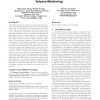Free Online Productivity Tools
i2Speak
i2Symbol
i2OCR
iTex2Img
iWeb2Print
iWeb2Shot
i2Type
iPdf2Split
iPdf2Merge
i2Bopomofo
i2Arabic
i2Style
i2Image
i2PDF
iLatex2Rtf
Sci2ools
MOBISYS
2009
ACM
2009
ACM
Air-dropped sensor network for real-time high-fidelity volcano monitoring
This paper presents the design and deployment experience of an air-dropped wireless sensor network for volcano hazard monitoring. The deployment of five stations into the rugged crater of Mount St. Helens only took one hour with a helicopter. The stations communicate with each other through an amplified 802.15.4 radio and establish a self-forming and self-healing multi-hop wireless network. The distance between stations is up to 2 km. Each sensor station collects and delivers real-time continuous seismic, infrasonic, lightning, GPS raw data to a gateway. The main contribution of this paper is the design and evaluation of a robust sensor network to replace data loggers and provide real-time long-term volcano monitoring. The system supports UTCtime synchronized data acquisition with 1ms accuracy, and is online configurable. It has been tested in the lab environment, the outdoor campus and the volcano crater. Despite the heavy rain, snow, and ice as well as gusts exceeding 120 miles per ...
MOBISYS 2009 | Robust Sensor Network | Sensor Station Collects | Wireless Networks | Wireless Sensor Network |
| Added | 25 Nov 2009 |
| Updated | 25 Nov 2009 |
| Type | Conference |
| Year | 2009 |
| Where | MOBISYS |
| Authors | Wen-Zhan Song, Renjie Huang, Mingsen Xu, Andy Ma, Behrooz Shirazi, Richard LaHusen |
Comments (0)

